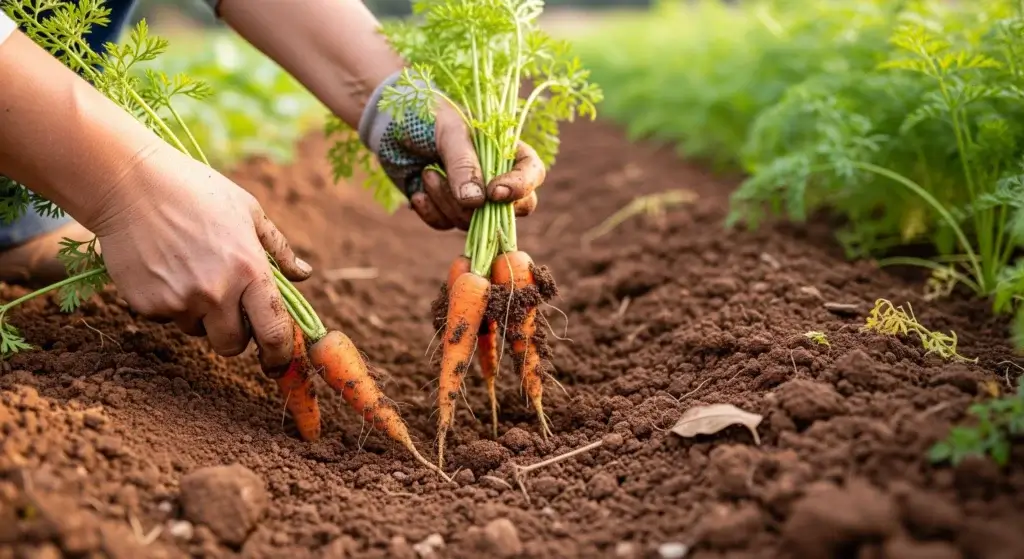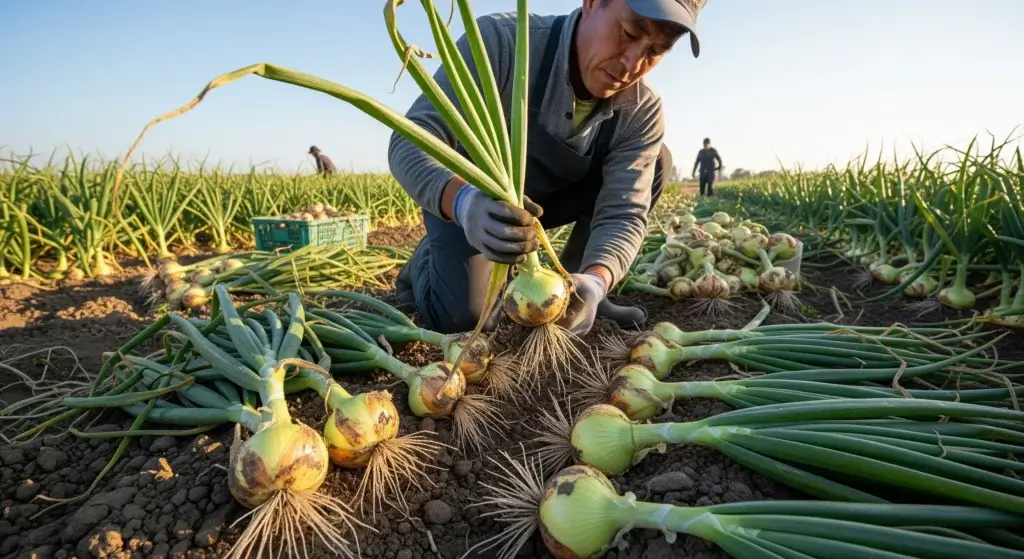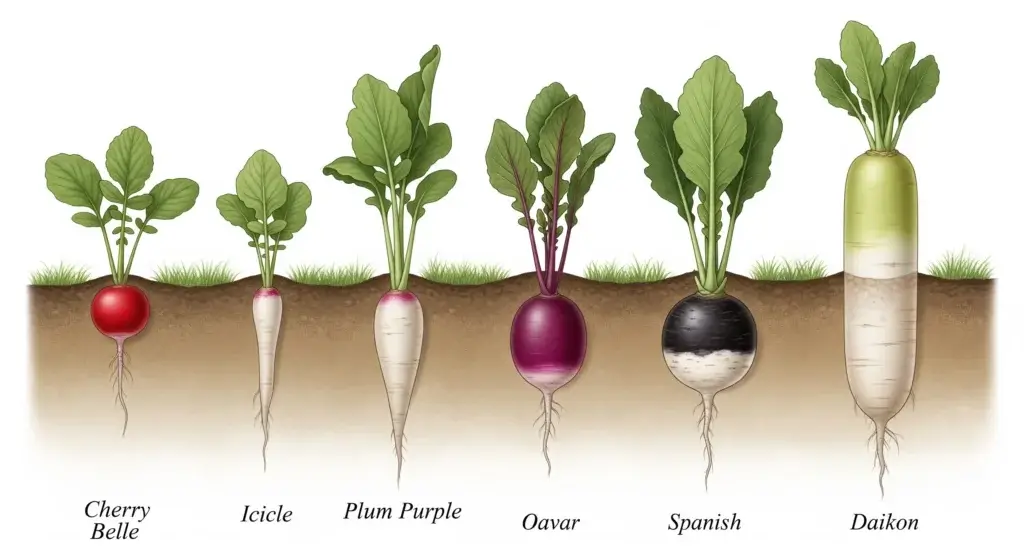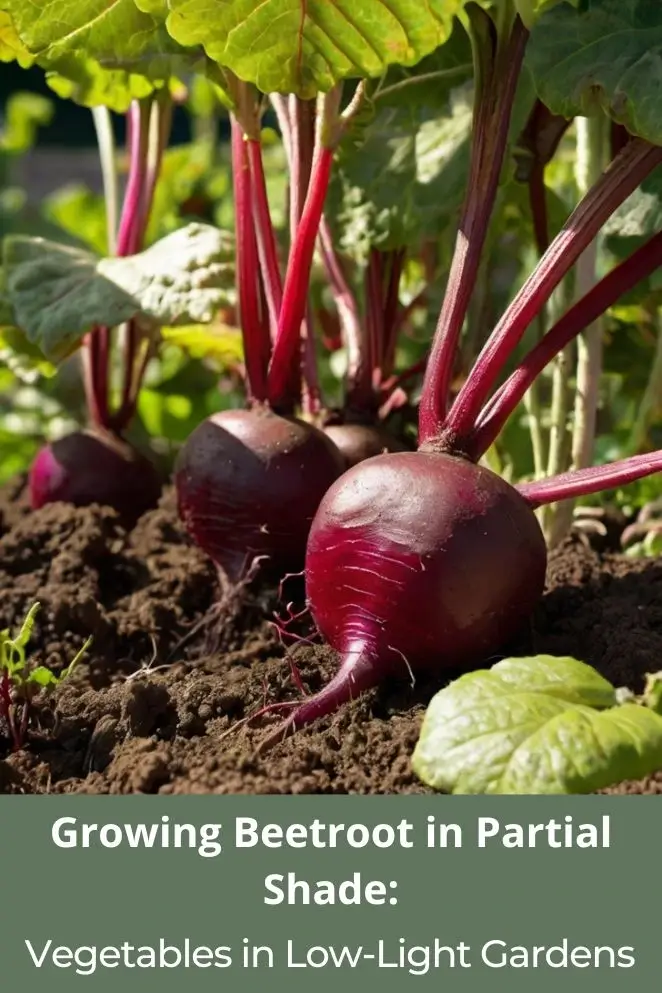
Beetroot actually grows just fine in partial shade. If your garden’s stuck behind trees, fences, or buildings, don’t stress—beets can still thrive.
This guide shows how to grow great beets even without full sun.
Shade doesn’t mean game over—it just means playing smarter.
Understanding Partial Shade
Before planting beets in a shady spot, you need to know what kind of shade you’re working with.
Not all shade is the same—and beets can handle more of it than you’d think.
The 4 types of shade
- Partial shade: 3–6 hours of direct sun
- Light shade: Filtered light, like under tree branches
- Dappled shade: Sun and shade shift all day
- Deep shade: Less than 3 hours of sun
Root crops like beets, radishes, carrots, and potatoes can grow with just 3–4 hours of sun, plus some dappled or light shade.
That’s great news if your garden’s more gloomy than sunny.
Watch how the light moves through your garden during the day.
Knowing where the sun hits—and for how long—helps you plant your beets in the best spot for solid growth.
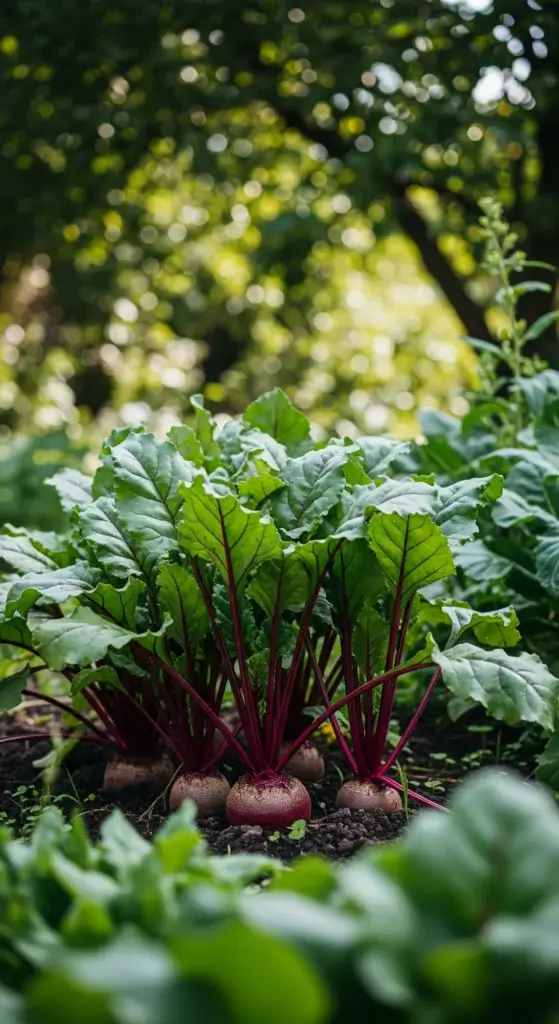
Why Beetroot Excels in Partial Shade Conditions
Beetroot isn’t like those sun-hungry veggies (looking at you, tomatoes).
It grows just fine in partial shade—and sometimes even does better there.
Here’s why beets are a smart pick for low-light gardens:
Shade slows bolting
Too much heat and sun make plants freak out and bolt (that means they flower early and stop growing roots).
In cooler, shaded spots, beets stay focused on growing—no rush, no panic.
More leaf, less drama
Less sun means the plant puts more energy into its greens.
That’s a win, because beet greens are tasty and super healthy.
Even if the roots stay small, you’ve still got food.
Moisture stays put
Shade = less sun = less evaporation. So the soil stays moist longer.
That means less watering for you and fewer stressed-out plants.
Fewer bugs
Pests love sun and heat. Shaded spots often have less insect drama, so your beets can chill in peace.
Smaller beets = sweeter beets
Yes, shade-grown beets might be smaller—but that’s not a bad thing.
They’re often sweeter, more tender, and less woody. Basically, they’re baby beets with personality.
Optimal Growing Conditions for Shade-Grown Beetroot
If your garden doesn’t get much sun, don’t panic—beets can still grow like champs.
You just need to set them up right. In the shade, details matter more, especially with soil and sunlight angles.
Fix the soil first
Shade slows things down a bit, so your soil has to be on point. Don’t just toss seeds into a random patch and hope for the best.
Here’s what your beetroot soil needs:
- pH: Keep it between 6.0 and 7.5 (slightly acidic to neutral).
- Drainage: Needs to drain well but still hold moisture—think sponge, not swamp.
- Organic matter: Add 2–3 inches of compost once a year. Skip fresh manure—it can mess up the roots and make plants bolt early.
- Texture: Soil should be loose and crumbly so roots can grow without hitting walls.
- Depth: Work the soil at least 8–10 inches deep. Beets are root veg—they need room to dig in.
Shade warning: Shaded soil stays wetter longer. That’s good for moisture, but bad if it gets soggy. Watch for root rot or funky mold. Raised beds or mounded rows can help keep water moving.
Use every bit of light you’ve got
In shady gardens, sun is gold. You have to be smart about where you plant.
Top beet-friendly spots:
- East-facing walls/fences – get morning sun, which is perfect
- West-facing areas – catch afternoon light
- Gaps between taller plants – great if you’re interplanting
- Edges of tree canopies – light filters through without blasting them
- Corners with reflected light – like next to a white wall that bounces light back
Bonus tip: Watch how shadows move as seasons change. That sunny spring patch might be too shady by summer when the trees fully leaf out. Track the light before planting.
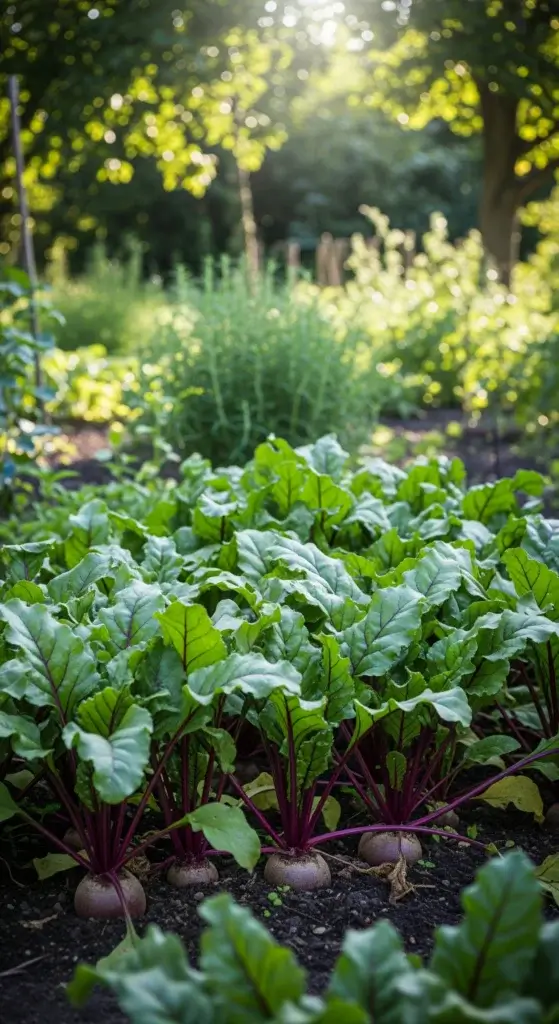
Best Beetroot Varieties for Partial Shade Growing
Not all beets love the shade equally. Some just handle low light better.
If your garden doesn’t get full sun, picking the right variety can make or break your beet game.
Top beets for root harvest in shade
These champs grow solid roots even without full sun:
- Boltardy – Super chill about shade and won’t bolt early.
- Detroit Dark Red – Classic, reliable, and shade-friendly.
- Burpee’s Golden – Bright orange roots that grow well with less light.
- Chioggia – The candy-striped beet. Looks cool, handles shade.
- Bull’s Blood – Mostly grown for its deep red leaves, but roots are decent too.
Best beets for leaf harvest in shade
If your garden is really shady, go for beet varieties grown for greens. You’ll get tons of tasty leaves even if the roots stay small.
- Early Wonder Tall Top – Big, tender leaves. Good for stir-fries or salads.
- Lutz Green Leaf – Big greens, and roots that still hold up.
- MacGregor’s Favorite – Great balance of greens and roots.
Planting Techniques for Shade-Grown Beetroot
Growing beets in partial shade? You’ll need to tweak how you plant.
Less light and cooler soil change the game—but with a few smart moves, your beets will still crush it.
Start seeds indoors first
Shady gardens can be rough for seed germination. A better move? Start your beet seeds in modules indoors where it’s warm and bright.
Then move them outside once they’ve got their groove.
Why this rocks:
- Seeds sprout faster
- You skip pests like soil gnats and slugs
- You can plant earlier
- The plants get a stronger start
Basically, you’re giving your beets a head start—like skipping the beginner level in a game you’ve already mastered.
Want to direct sow anyway? You still can
If you’d rather plant straight into the ground, that’s fine too. Just tweak your method a bit for shady spots:
- Plant shallower than usual (light helps germination)
- Space seeds out more so they’re not fighting for light
- Pick warm soil days—wait a little longer in spring
- Watch for slugs—they love cool, damp areas
- Try succession planting so you’re not putting all your beets in one basket
Timing Is Different in Shade
Shade slows things down. The soil stays cooler in spring and fall, so wait 1–2 weeks longer to plant compared to sunny spots.
But the upside? You get a longer growing window once they’re in.
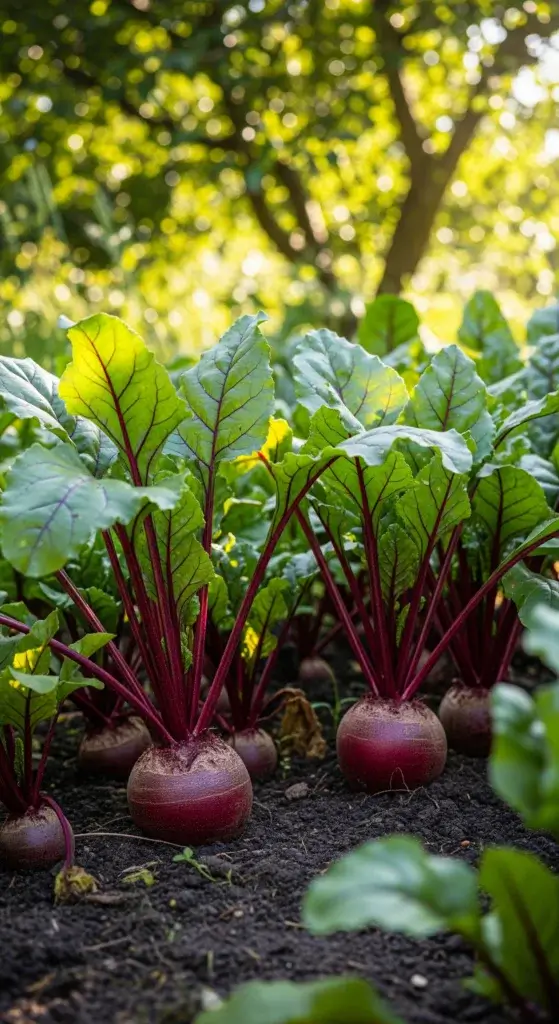
Essential Care and Maintenance Practices
Beets can grow in shade, but they do need a little extra attention.
Less sun means cooler soil, slower drying, and slightly different nutrient needs.
Here’s how to keep your shade-grown beets healthy without overthinking it.
Watering in the shade
Shady spots hold onto moisture longer, so don’t water on autopilot.
Here’s the game plan:
- Stick your finger 2–3 inches into the soil. If it feels damp, skip watering.
- Water deep but not often. You want roots to grow down, not stay lazy near the top.
- Aim water at the soil, not the leaves. Wet leaves = fungus city.
- Use mulch to hold moisture steady and keep the soil from bouncing between dry and swampy.
Good signs:
- Soil is moist, not soggy.
- No puddles after watering.
- Plants look perky, not droopy (especially in the morning).
Feed them right
In shade, beets don’t burn through nutrients as fast, so go easy on the fertilizer.
Do this:
- Ease up on nitrogen. Too much = tons of leaves, tiny roots.
- Focus on phosphorus (for strong root growth) and potassium (for keeping plants healthy).
- Use slow-release or organic fertilizers so you don’t have to feed constantly.
Organic go-tos:
- Compost: 2–3 inches once a year is plenty.
- Fish emulsion: Dilute it, use every 3–4 weeks.
- Bone meal: Add it when planting for root boost.
- Kelp meal: Adds trace minerals and helps with stress (for the plant—not you).
Troubleshooting Common Challenges
Growing beetroot in partial shade presents unique challenges that differ from full-sun cultivation.
Understanding and addressing these issues ensures successful harvests and healthy plant development.
Managing pest and disease
Moist, shaded spots can invite some unwanted guests. Here’s who might show up:
- Slugs & snails: They love damp, shady hangouts.
- Fungal diseases: Wet leaves and tight spacing = mold party.
- Root rot: Too much water and not enough drainage.
- Slow growth: The longer things grow, the more risk of issues.
Fix it like this
- Space your plants out. Air flow matters.
- Use copper tape or slug traps. Beer traps also work—cheers.
- Only water the soil, not the leaves. Keep foliage dry.
- Fix drainage early. Raised beds or compost help.
- Check plants often. Catch problems before they spread.
Growth and development issues
Plants in partial shade may exhibit different growth patterns and development timelines compared to full-sun specimens.
Understanding these differences helps optimize your management approach.
Common growth challenges
- Smaller roots
- Bigger leaves
- Longer time to harvest
- Plants might stretch toward the light (a.k.a. “etiolation”)
Optimization techniques
- Pick the right beet variety for shade (see the earlier list).
- Feed them well, but not too much. Go easy on nitrogen.
- Give them space so light reaches each plant.
- Use reflective mulch (like silver or white plastic) to bounce light back up.
- Adjust your timeline. Beets will still grow—just slower.
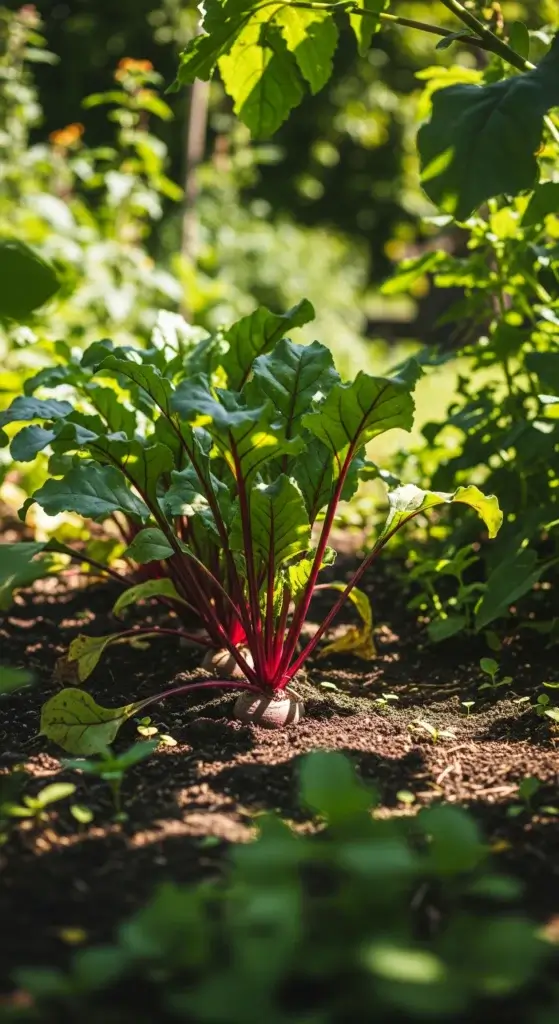
Final Take: Shade-Grown Beets Are Totally Worth It
Growing beets in partial shade isn’t a backup plan—it’s a smart move.
You just need the right variety, solid soil, and a few tweaks to how you plant and care for them.
Smaller roots? That’s fine—they’re often sweeter and more tender. And the greens? Super productive and packed with nutrients.
Shady gardens can still grow serious food.
Start with beets, learn as you go, and use that knowledge to grow other shade-friendly crops too.
Less sun doesn’t mean less success—it just means gardening a little differently.

